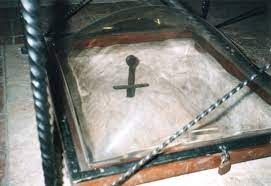A certain ancient mystery is related to the Abbey of San Galgano, located in the beautiful Val de Merse just 35 km south of Siena, Italy.
Long ago, in the 12th century, the former knight Galgano Guidotii lived in nearby Chiusdino, not far from Florence, Italy. Born into an aristocratic family of Chiusdino, Galgano wasn’t a quiet man. In other words, he was a troublesome and ruthless individual.

The Sword in the Rock inside Montesiepi Church. Image source
One day, something happened in his life. He had a vision in which he saw the archangel Michael, and after this experience, Guidotii decided to convert. He retired and became a hermit near his hometown.
In accordance with the advice received from heaven and exactly as he saw it in his vision, he drove his sword into a bare, large boulder, so only the cross of the handguard protrudes from the rock, and it still exists today.
His deed symbolizes both a sign and a change that took place in the knight Galgano’s life.
According to the legend, many tried to steal the sword. Nobody succeeded. In the chapel, there are still mummified hands (why only hands) of a thief, who was suddenly attacked and killed by wild wolves.
Were the mummified hands left as a warning if any future sword snatcher decided to get it?
Putting aside this ancient legend, it is not known how the sword found itself in the rock.
Nobody has such a great strength to punch more than a meter-long sword in solid rock. Many people say that this is a miracle, but not all believe this is the case.
Scientific Research Did Not Shed Light On Mystery
It’s worth mentioning that research was conducted in 2001 at the monks’ request. Scholars from the University of Pavia (a renowned university founded in 1361 and located in Lombardy, Italy) confirmed the sword’s origin from the twelfth century and its place in the rock.

Left: Adoration of the Shepherds between Saints Augustin and Galgano by Pietro di Giovanni d’Ambrogio. source; Right: Abbey of San Galgano. source
The samples confirmed that the sword’s chemical composition definitely corresponds to the contemporary metal alloys used by armorers at the end of the 11th and beginning of the 12th century, and thus the time when Galgano Giudotti lived.
The sword actually comes from the Middle Ages. Experts used X-rays and a very small (10-mg) sample in the tests.
It has been confirmed that the upper piece and the invisible lower one (plunged into the rock) are authentic and belong to the same artifact.
Galgano died in his hermitage on November 30, 1181. He lived only 33 years.
Src: ancientpages.com








